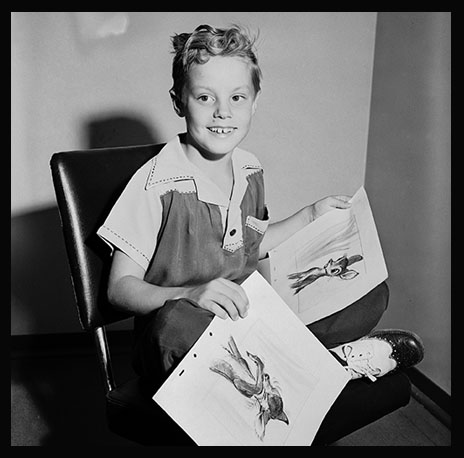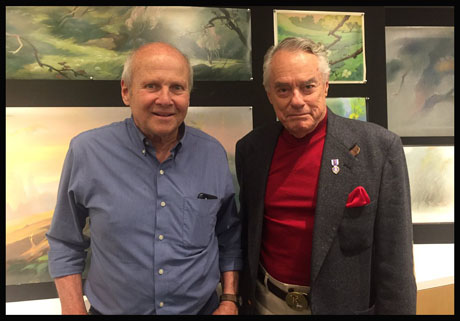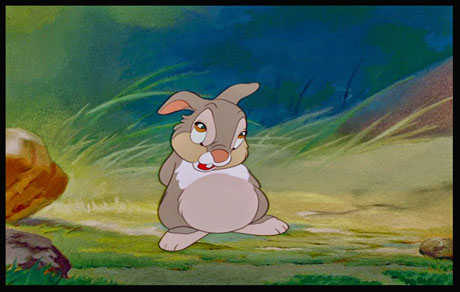
Bambi, the classic 1942 Disney feature known and loved around the world, is celebrating its 75th anniversary with a new collection on digital HD debuting today (May 23rd) – and on blu-ray on June 6th. As is often the case with these new releases, there’s a slew of new bonus material to make it essential to Disney fans, including deleted scenes and a feature on artist Tyrus Wong. Two voice artists who worked on the film, Donny Dunagan and Peter Behn, have been doing interviews about what they remember of that time, and their personal perspectives on how Bambi has shaped the history of film.

“Love is a song that never ends”: An interview with the voice of Bambi, Donny Dunagan
Donny Dunagan caught the attention of a movie scout as a three year old, after winning the $100 prize for tap dancing at a talent contest in Memphis. He was sent out to Hollywood, and once there made seven films between 1938 and 1941. His most well-known and enduring role was as the voice of young Bambi. Even more impressive, however, is the fact that he grew up to become the youngest Assistant Drill Instructor in U.S. Marine Corps history, and was the recipient of numerous U.S. Military awards, not least of which for carried a wounded Corporal off the field of battle under heavy fire during his tour in Vietnam.
In 1977, he played a major role in getting the the Department of Defense to allow the dispersement of food from service warehouses to widows of WWII servicemen, for which he was honored with Citizen of the Year for the Military Sector. While he rarely spoke about being the voice of the “young prince” during more of his adult life, he has recently found great joy in embracing his part in making Bambi an enduring classic. Leslie Combemale interviewed Donny for Animation Scoop about his memories and thoughts about the film:
LC: have you been enjoying this tour of talking to people about your history?
Donnie: I cannot tell you what joy Bambi has been in my life. I had a lot of years living in a violent mode, in a military mode, all over the world, and I’ve seen some tough things, but since the folks at Disney found out this old boy was still alive, talking about it has been the joy of my life, times 10!
Talking with everyone from children to their granddaddies and grandmothers in all kinds of environments, it makes me a little miffed that I did not volunteer to people before 10 years ago, 12 years ago, that I had a relationship with any of this. All the movies I made before Bambi, and the wonderful Bambi, I didn’t talk about any of it. I’ve never been a fan of men who brag and boast about things, so I never said anything about it at all. But in the last 10 years, I’ve been able to do more good for more people one-on-one, one-on-50, and one-on-200 with Bambi than I could if I had been in the White House for decorations 55 times. It’s a wonderful surprise.
LC: As to that, I would like to thank you for your service, because you have quite a history, having been wounded and done a great deal of good in your life in the military. It’s a big deal. But I think it’s really funny that you’ve probably just discovered – My experience with Bambi and talking to people who have seen it, is that it’s one of the Disney movies that is universally loved. Men especially really love that movie. There’s a soft spot for it, regardless of age or gender, which I’m sure you’ve discovered…
Donnie: It has a story component for every phase of life. I don’t think I’ve ever seen a movie in any country, any language, where the storyline starts with birth and follows the child through all the young years, all the experiences, all the mistakes, all the silly things, all the way to maturity. I think that is the key to it. It doesn’t hide from the sadness, and it certainly doesn’t hide from the laughter.
If you saw me trying to skate… they tried to teach me how to ice skate at age 6, right? I could’ve been the model for Bambi on the ice. I was terrible. Everybody relates to it, to those things in the story, out of their own lives. I think you hit it right on the head.

LC: Bambi came out in 1942, so it was actually out during WWII, so there were a lot of military guys who saw the movie, and it really did uplift their spirits. I know i’ve spoken to a number of fans who remembered seeing it back then. And even in retrospect, you know people who had gone through a number of those kinds of really difficult experiences, something about Bambi just brings them joy.
Donnie: Very perceptive. Nobody in all the interviews I’ve done in the last 10 years has made that point. But let me tag onto that just for a second. I was reading reasonably well at age 5, I was a bit precocious. I think I was 5 or 7 during the production of Bambi, of my part of it anyway, so maybe I was 5 or 6, but going on 19, as they say. Not jaded, but aware….and Pearl Harbor struck us. We cannot relate to that very well today, and that’s a good thing– but we were mesmerized. I mean, people were walking around like zombies and, I mean, really hammered down, and in pain. We’d already had the depression for several years which had hammered us down. Attitudes and smiles were muted in this country. The Pearl Harbor event, our entry into WWII, which we’d already witnessed in Europe for a couple years, was a real…may I use a corny word?…a real ‘downer’ for everybody.
Bambi came along at just the right time and it lifted people up. You could hear people talking about it, about the song, “Love is a Song that Never Ends,” was sung by people all over the place and most of them messed up the words, but it didn’t matter. Mr. Disney knew what he was doing with the release of Bambi, and I really believe it helped this country.
LC: And there’s also such messages of self-sufficiency, to have that come out during WWII when people were really having such a hard time with rations and with their families being gone, you know, with missing dads and sometimes missing moms working in the machinery factories. I think it brings that message home as well, and that has traveled all the way from 1942 to now.
Donnie: I just had a great time just a week and a half ago with 200 4th and 5th graders in Texas in a gymnasium, where I was invited to come and spend an hour with them. I get those kind of invitations, probably when I don’t deserve it, many, many times, and this was the most recent one. Some of the children who had a previous edition of Bambi at home were envied by the children who can’t wait for the new one to come out. They’ve all heard about it. And I asked for hands for the children who’ve seen it recently, and about one out of four raised their hands. I got input by asking them: What do you remember about that? What was the most exciting about it? What did you learn from that? And the messages from the children, what Mr. Disney communicated in Bambi, was kindness and loyalty. They also all picked up on the mother loss. Children pick up on that themselves. Not from me. And I’m standing there in front of 200 children and they coach me on Bambi, it’s just wonderful.

Peter Behn (Thumper) and Donny Dunagan (Bambi) today. Photo by Kevin Polowy.
LC: My experience of Disney movies is that every different age group thinks it came out for them, even though it’s actually 75 years old. So when you talk to someone who is in their 30s or in their 60s, they all think it was made for them. Very few films have that level of agelessness.
Donnie: That’s an excellent point.
LC: So, you were the model of Bambi. How did that come about for you and do you remember any of that?
Donnie: I remember all of it. That was my seventh or eighth film and my first animated. That made it an extra adventure. I didn’t have to go on camera and prance around like I did with the other films. I’m in a sound booth and when I was not in a sound booth at Disney Studios, they were treating me very nicely, me and my mother, every day, all the time. So that was a very fresh, new adventure. I’ve shared this little cameo with several people in the past. Let me share with you. Several scenes in Bambi that there were modeled for the face, have an extra resonance with me. One of them is the little scene where Bambi does something silly. He’s in the thicket, feeling sorry for himself. And little Feline, the girl deer, sticks her head through the thicket, and gives him a deer kiss, a lick on the cheek, and he frowns and looks like, “Oh my gosh, this is terrible.”
That’s what you do when you discover the wonder of girls in your life. He’s frowning and, “Oh my gosh, don’t do that to me.” They wanted me, sitting on a stool, to look like I was angry about something. I had a hard time doing that, because I was having the time of my life. How do you look mad when you’re happy? One of the artists with a million pencils all over the place said, “Donnie, pretend like something bad has happened to you,” and I mentioned castor oil that my mother had given me, and he said, “You just had a bad dose of castor oil, what do you think?” And I put this terrible frown on my face and they drew it. They said, “Hold it!” It’s hard for a kid to hold a frown, but I did for a good bit of time. So now I tell everybody that story, and kids love this: that when they see the wonderful scene in Mr. Disney’s Bambi, that’s what I call “the castor oil kiss scene.”

“That’s why they call me Thumper”- The voice of Thumper, Peter Behn, answers a few questions for Animation Scoop:
Peter Behn was the son of famous screenwriter Henry Behn, and so when the studio announced they were looking for the voice of Bambi, he auditioned. It was Frank Thomas and Ollie Johnston who thought he’d be perfect for Thumper, and so Peter was hired to take on the role. During the filming, his family decided to relocate, so Peter travelled back to Hollywood to finish his voice work on Bambi, and then turned toward other endeavors, leaving acting behind. He went into the army and to studied at Yale on the G.I. Bill. Over the years, he built and sold homes, and eventually retired in Utah, where he has a “green” home, with a wind generator, solar panels and a rain harvesting system. What a perfect way to live, given one of Peter’s first jobs was as the voice of a bunny! I asked a Peter a few questions about his perspective on the film:
LC: Do you remember any of the animators or your interactions with any of them? I mean, I know Frank and Ollie were probably the two that hired you right?
Peter: Well, I guess that they were very influential in telling Walt that my voice would be right for the rabbit, of course Thumper, and I did meet them and I met some of the other animators but it wasn’t often. There were eight recording sessions over a period of two years and basically I was there on set for the recordings so I didn’t have a huge long-term relationship with the animators.
LC: Did you ever experience them drawing while you were recording or did you get to go in and see any of them doing any of the drawing?
Peter: I did go through the animation studio but obviously not while I was recording. I did get a couple of drawings from the animators that I still have; original sketches of Thumper that I feel very warm about.
LC: And did the animator actually hand you the drawings that you have?
Peter: Yes, of course.
LC: And what scene were they from?
Peter: They weren’t from a scene, they were study sketches of Thumper, just a simple pencil sketch.
This particular sketch that I’m referring to, we framed and it’s hanging on the wall in my bedroom. The house is not full of memorabilia. It was a part of my life that I don’t dwell on every day but I’m very proud to be a part of.
LC: I kind of love that you have a house that has a lot of efficiency and is very kind of one with nature to some degree. There’s a lot of solar stuff. I like that your Thumper drawing lives within that world with you. The movie Bambi had a wonderful naturalistic look to it.
Peter: Well, that’s very true and one of my strong feelings and impressions and memories of the movie is that it was a very early environmental statement by Walt. I’m constantly impressed with his vision that we needed to protect our environment and our world, and that man was the enemy, or the risk, for the future of our environment.
- CREATING COCO: An interview with Pixar’s Jason Katz, Story Supervisor - November 22, 2017
- OPEN LETTER: Animation Insiders Demand a Change from Sexism and Harassment in the Animation Industry - October 19, 2017
- The Glorious Labor of LOVING VINCENT: An Interview with filmmakers Dorota Kobiela and Hugh Welchman - September 28, 2017


 May 23rd, 2017
May 23rd, 2017  Leslie Combemale
Leslie Combemale  Posted in
Posted in  Tags:
Tags: 






